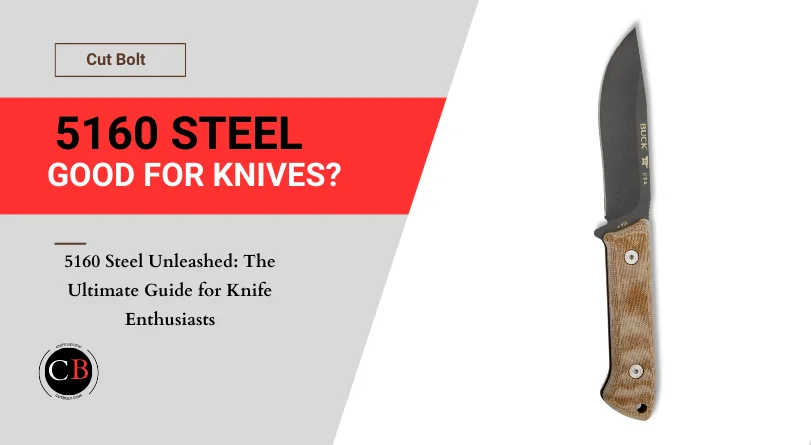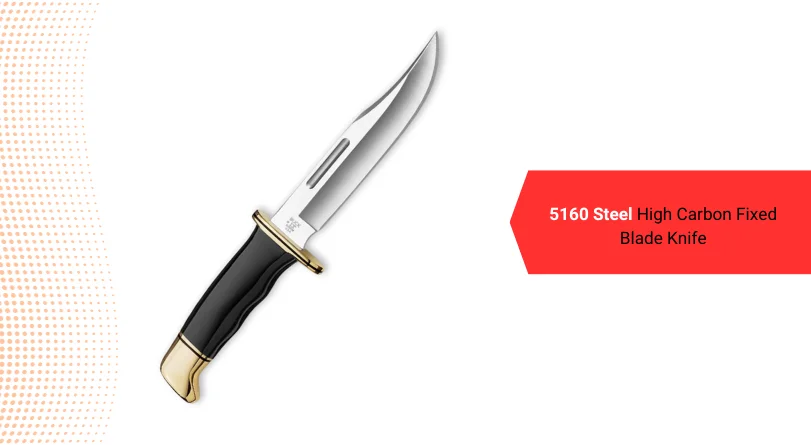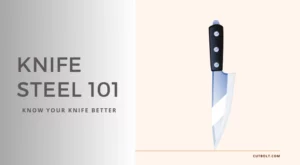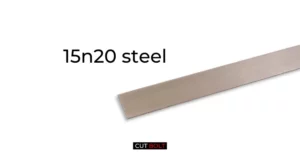As a knife fan if you have not yet had an encounter with 5116 steel, sooner or later you stumble across 5160 steel. At least that’s what happened to me. And the fact that you are reading this means that it is similar for you and that you would like to know more about this steel.
So let’s get the most important thing out of the way – is 5160 steel good for knives? Yes. It has what a good knife steel should have. But to understand it fully, you should read on to learn more about its chemical composition, its hardness, and what else makes it special.
Table of Contents
What is 5160 steel?
5160 is a low alloy spring steel with high carbon and chromium content. It is a very tough steel with high impact strength. It is used for swords, large knives, in the automotive industry and here mainly for leaf springs. Spring steel is a designation for low-alloy manganese, medium and/or high-carbon steel with a high yield strength.
The first digit of the nomenclature for steel alloys stands for the class of the steel alloy. In the case of 5160 steel, the 5 represents steel alloys using chromium as the main alloying element. The second digit stands for the concentration of said alloying element – so 5160 steel consists of 1% chromium by mass. The last two digits stand for the specific concentration of carbon, i.e. they indicate that the alloy contains 0.60% carbon.

5160 steel chemical composition
5160 consists essentially of a low manganese and medium carbon content, typical of all spring steels. However, this spring steel has been modified with added chromium to improve its hardenability. Here is the complete composition of 5160 steel:
| Element | Portion | Effect |
| Chrome | 0.9% | Improves wear resistance, heat resistance and scale resistance. It increases tensile strength because it acts as a carbide former. Use of rust-free or stainless steel, as it increases corrosion resistance from a mass proportion of 12.2%. Reduction in weldability. |
| Carbon | 0.64% | Increasing hardness and tensile strength. In larger quantities, increase in brittleness and reduction in forgeability and weldability. |
| Manganese | 1.0% | Improves hardness and tensile strength. |
| Phosphorus | 0.035% | Increases tensile strength, hardness and corrosion resistance but also brittleness. |
| Sulfur | 0.04% | Increases machinability but also brittleness. |
| Silicon | 0.3% | Improves strength. |
We can see, 5160 steel consists of a mixture of carbon, chromium and manganese in roughly equal parts.
What is the hardness (HRC) of 5160 steel?
With a hardness of 57-58 HRC, 5160 is a hard steel, but not a super-hard steel.

When a suitable heat treatment is applied, 5160 steel reaches a hardness of 57-58 HRC. This is quite a decent hardness for steel, falling in the middle range between hard steels (60 HRC and above) and soft steels. This decent hardness in turn means that this steel also has decent wear resistance and does not lose its sharpness immediately after a few cuts.
Is 5160 stainless steel? Or rustproof steel?
5160 steel is neither a rustproof steel nor a stainless steel. To be considered corrosion resistant, it would require a chromium content of at least 10.5 – 13% dissolved in austenite or ferrite, depending on the definition.
5160 is not a stainless steel either, since its sulfur and phosphorus content (so-called iron companions) exceeds 0.025%.
Properties of 5160 steel
According to the chemical composition and hardness of 5160 offers:
5160 steel edge retention
5160 spring steel has good edge retention. Not the best, it is too soft for that, but quite acceptable. The comparatively low carbon content compared to much harder steels is responsible for the fact that fewer carbides are formed, which hurts the long-term maintenance of sharpness.
5160 spring steel knives must be sharpened regularly, especially when cutting hard materials with them. Despite all this, a 5160 steel blade keeps its sharpness better than most other knives in this hardness range available on the market.
Corrosion resistance
The 5160 spring steel is susceptible to rust or rather can rust in no time if you are not careful. Chromium has a significant effect on corrosion resistance, and the comparatively small amounts contained in it (0.70-0.90%) are to blame for this problem.
What may sound dramatic now is not so difficult to counteract in reality: simply clean the knife after use, wipe the blade with an oily cloth, and store the knife in a dry, non-corrosive place!
Wear resistance
This spring steel offers decent wear or abrasion resistance. This is because it has a sufficient carbon content, which provides a decent hardness. Decent wear resistance further means that the steel has good durability and can easily withstand normal wear and tear with regular use compared to softer steels.
Sharpness: is 5160 a good knife steel?
The harder a knife steel, the harder it is to sharpen, 5160 tends to be a hard steel, but not super hard. It is easy to sharpen. A high percentage of chromium carbides in a steel alloy commonly makes steels difficult to sharpen.
This is also why super steels with high chromium content are the hardest to sharpen. Conversely, steels such as 5160 with low chromium content are low in carbides and are therefore comparatively easy and quick to sharpen. In addition, a very sharp cutting edge can be achieved with simple sharpening tools.
Toughness
5160 steel offers excellent toughness! The low carbide content in this steel allows for really high toughness compared to many other steels. A quick look on outdoor forums illustrates its great performance in performing tough tasks such as batoning, chopping wood, etc. without breaking or chipping.
For “Outdoor and survival” – a softer, tougher steel is best suited for more than just these types of tasks. It may not stay sharp as long, but it can be made sufficiently sharp again with simple means in the field. After all, what good is a super steel that has become dull if there is no grinding machine at hand?
Machinability
On the other hand, 5160 is a very hard steel in terms of machining. In addition, the steel must be annealed before machining to achieve maximum speeds and feeds. As a rule of thumb, steels up to 60 HRC can be machined or annealed with normal tools.
Welding
5160 is not suitable for welding.
Forging
5160 steel is forged between 1149°C – 1204°C (2100°F – 2200°F).
Heat Treatment
Generally, 5160 is hardened in oil. For quenching, the best temperature is 830°C (1525°F), and for tempering it is between 425 and 700°C (800 and 1300°F).

My opinion: Is 5160 steel good for knives?
My answer is yes, 5160 is a great knife steel – except for its corrosion resistance. Its edge retention is good, as is its hardness, toughness and wear resistance. So if you’re looking for an exceedingly affordable and sturdy knife that can take a beating, 5160 is a good choice.
On the other hand, if you intend to use it primarily in wet environments, such as fishermen, hunters, divers, or even chefs, you probably won’t be happy with a 5160 steel knife.
As I have mentioned, it is susceptible to corrosion and will rust very quickly. Of course, this can be largely prevented by appropriate care – cleaning and oiling after use. But it is not an insignificant additional expense for frequent use, which simply does not occur with stainless knives made of H1 or LC200N, or in the budget range 420HC.
Related: Pros and Cons of A2 steel to learn before buying
Steel equivalent to 5160
The British equivalent to the 5160 steel is the spring steel BS 527H60. The composition of the steels is 100% identical, which means they offer the same exceptional toughness and good wear resistance when used to make knives.
Other steels equivalent to 5160 spring steel include the German DIN 65MnCr4 and DIN 60Cr3 steels, as well as the Chinese GB 60CrMnA (source: zknives). These steels have the same chemical composition as 5160 and thus offer pretty much the same performance.
Comparison of 5160 steel with similar steels
In this section, I again specifically compare the key properties of 5160 and 1095.
5160 steel vs. 1095
1095 is also a spring steel. However, 1095 has a higher carbon content than 5160, so it has higher wear resistance and better edge retention than its counterpart. 1095 steel is also easy to machine, but 5160 is easier to sharpen compared to it.
Both steels offer poor corrosion resistance, but 5160 is worse than 1095. Although 1095 is also tough, its toughness is nothing compared to 5160. The bottom line is that 1095 offers the same performance as 5160, but with lower toughness.
5160 vs D2 steel
D2 has a higher carbon content and offers better edge retention than 5160 steel. Also, D2 is not the very best in corrosion resistance (D2 is semi-stainless steel), but beats 5160 with its better anti-rust performance. However, the toughness of D2 is lower than 5160 spring steel. Also, D2 is harder to sharpen.
5160 vs 420HC steel
420HC is a lower-end steel and a variation of the old 420 steel. This steel offers about the same corrosion resistance as 5160, containing 13% chromium, which is unlike our rust-prone 5160 steel. However, 5160 is better in terms of toughness and a better sharpness than 420HC.
5160 vs 9260 steel
9260 also produces a super-tough blade and is a major competitor to 5160 in the sword industry. This steel is even more flexible than 5160 steel, allowing it to be bent up to 90 degrees and still return to its original shape, making it best suited for sword making. However, 9260 is considered an exotic steel and is more expensive than 5160.
5160 vs S30V steel
S30V is a premium knife steel that offers far better edge retention than 5160 steel. It also contains a lot of chromium and is a rust-free steel, thus offering better corrosion resistance than 5160. It is also much harder and thus more difficult to sharpen than 5160.
Final words: Is 5160 steel good for knives?
Both knife makers and knife users should keep 5160 steel in mind because it is a great knife steel. However, as a non-rustproof steel, it needs more care and attention than corrosion-resistant steel. This also makes it less(less) suitable for applications in environments that tend to be wet.
Though, it’s a great steel for large knives and swords, hard but poor in machining (which explains why it’s not very popular for small knives).



